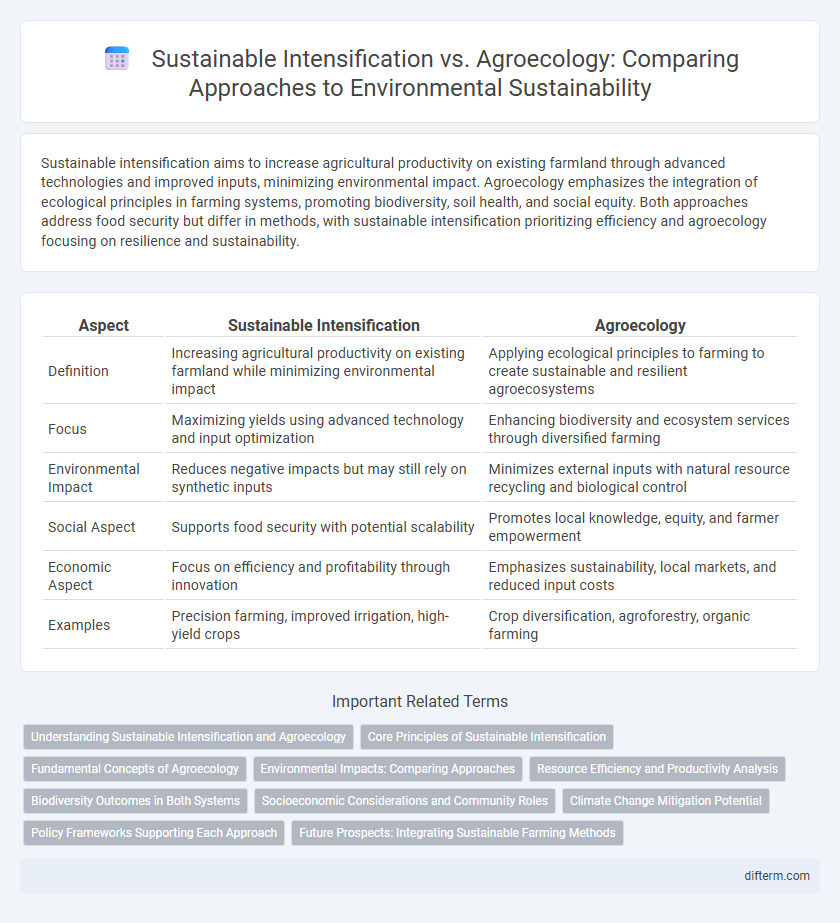Sustainable intensification aims to increase agricultural productivity on existing farmland through advanced technologies and improved inputs, minimizing environmental impact. Agroecology emphasizes the integration of ecological principles in farming systems, promoting biodiversity, soil health, and social equity. Both approaches address food security but differ in methods, with sustainable intensification prioritizing efficiency and agroecology focusing on resilience and sustainability.
Table of Comparison
| Aspect | Sustainable Intensification | Agroecology |
|---|---|---|
| Definition | Increasing agricultural productivity on existing farmland while minimizing environmental impact | Applying ecological principles to farming to create sustainable and resilient agroecosystems |
| Focus | Maximizing yields using advanced technology and input optimization | Enhancing biodiversity and ecosystem services through diversified farming |
| Environmental Impact | Reduces negative impacts but may still rely on synthetic inputs | Minimizes external inputs with natural resource recycling and biological control |
| Social Aspect | Supports food security with potential scalability | Promotes local knowledge, equity, and farmer empowerment |
| Economic Aspect | Focus on efficiency and profitability through innovation | Emphasizes sustainability, local markets, and reduced input costs |
| Examples | Precision farming, improved irrigation, high-yield crops | Crop diversification, agroforestry, organic farming |
Understanding Sustainable Intensification and Agroecology
Sustainable intensification increases agricultural productivity on existing farmland to minimize environmental impact, emphasizing resource efficiency and technological innovation. Agroecology integrates ecological principles into farming, promoting biodiversity, soil health, and social equity through traditional knowledge and local practices. Both approaches aim to enhance food security while reducing agriculture's ecological footprint, but differ in methods and underlying philosophies.
Core Principles of Sustainable Intensification
Sustainable intensification revolves around increasing agricultural productivity on existing farmland while minimizing environmental impact, emphasizing resource-use efficiency, preservation of natural ecosystems, and reduction of greenhouse gas emissions. Core principles include enhancing crop yields through technology and improved management, integrating water and nutrient cycles, and promoting biodiversity to support ecosystem services. This approach strives to balance food security with ecological sustainability by optimizing inputs and maintaining soil health.
Fundamental Concepts of Agroecology
Agroecology emphasizes the integration of ecological principles into agricultural systems, promoting biodiversity, soil health, and resource efficiency to achieve sustainability. Unlike sustainable intensification, which focuses on increasing productivity within existing agricultural land, agroecology prioritizes social equity, local knowledge, and resilience to environmental changes. Key concepts include nutrient cycling, polycultures, agroforestry, and community involvement, fostering harmonious interactions between humans and ecosystems.
Environmental Impacts: Comparing Approaches
Sustainable intensification seeks to increase agricultural productivity on existing farmland while minimizing environmental impacts through improved resource efficiency and technological innovation. Agroecology emphasizes biodiversity, ecological processes, and social equity to create resilient farming systems that enhance soil health, preserve ecosystems, and reduce chemical inputs. Comparative studies indicate agroecology often achieves greater long-term environmental benefits by promoting biodiversity and ecosystem services, whereas sustainable intensification may risk environmental trade-offs despite boosting yields.
Resource Efficiency and Productivity Analysis
Sustainable intensification enhances resource efficiency by maximizing crop yields on existing farmland through advanced technologies and improved management practices, minimizing environmental impacts. Agroecology emphasizes biodiversity and ecosystem services, promoting productivity by integrating ecological principles that sustain soil health and reduce dependency on external inputs. Comparative analyses reveal sustainable intensification delivers higher short-term productivity gains, while agroecology supports long-term resilience and resource conservation.
Biodiversity Outcomes in Both Systems
Sustainable intensification promotes higher crop yields on existing farmland, often relying on advanced technologies and input management, which can lead to moderate improvements in biodiversity by reducing the need to convert natural habitats. Agroecology emphasizes ecological principles and diversity within farming systems, fostering greater biodiversity through crop rotations, polycultures, and habitat conservation. Studies indicate agroecological approaches generally support richer species diversity and enhanced ecosystem services compared to sustainable intensification practices.
Socioeconomic Considerations and Community Roles
Sustainable intensification emphasizes increasing agricultural productivity through technological innovations while addressing socioeconomic factors such as access to markets and financial services to enhance farmer livelihoods. Agroecology prioritizes local knowledge, community engagement, and equitable resource distribution, fostering social cohesion and empowerment of smallholder farmers. Both approaches necessitate inclusive policies that recognize community roles in decision-making and sustainability outcomes.
Climate Change Mitigation Potential
Sustainable intensification enhances agricultural productivity through improved resource efficiency, reducing greenhouse gas emissions per unit of output and contributing significantly to climate change mitigation. Agroecology emphasizes ecological principles and biodiversity, promoting carbon sequestration in soils and resilience against climate impacts. Both approaches offer complementary pathways to reduce agriculture's carbon footprint and support climate-smart food systems.
Policy Frameworks Supporting Each Approach
Policy frameworks supporting sustainable intensification prioritize advanced technologies, improved crop varieties, and resource-efficient practices to increase agricultural productivity while minimizing environmental impact. Agroecology-focused policies emphasize biodiversity conservation, local knowledge integration, and social equity, promoting resilience and ecosystem health through holistic, participatory approaches. Both frameworks require tailored regulations, incentive programs, and cross-sector collaboration to effectively address food security and environmental sustainability.
Future Prospects: Integrating Sustainable Farming Methods
Future prospects for integrating sustainable farming methods emphasize combining sustainable intensification's focus on increasing productivity per unit of land with agroecology's principles of biodiversity and ecosystem health. Advances in precision agriculture, agroforestry, and soil health management enable synergistic approaches that enhance resilience to climate change while maintaining food security. Policy frameworks and participatory research are critical to scaling practices that balance environmental sustainability with agricultural innovation.
sustainable intensification vs agroecology Infographic

 difterm.com
difterm.com